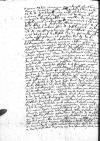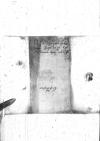Reddidit mihi Psitacus litteras unas, ⌊Mauricius⌋ vero alteras Reverendissimae Dominationis Vestrae litteras. De ⌊vicino⌋ quod scribit, gratum fuit ⌊reverendissimo domino⌋ cognoscere. Spes est fore, Christo inspirante, ut paulatim ad unitatem ecclesiae redeat. Iam enim quas repudiaverat caeremonias, eas revocare videtur. Ceterum est quod nobis metuamus, posteaquam ⌊sancta illa anima⌋ in beatorum sedes est recepta. Neque enim fieri potest, ut eadem sint erga nos voluntate serenissimi ⌊fratres illi⌋, qua superstite ⌊illa⌋ fuerunt; nisi forte, quod in scheda ad ⌊reverendissimum dominum⌋ scripsit Reverendissima Dominatio Vestra, id eveniat, quod quidem optare magis licet, quam sperare. Nam penes quos nunc summa potestas est, ii ⌊fratribus istis⌋ non optime velle videntur. Deinde vero nescio qui rumor in ⌊Germania⌋ sparsus est, ut ⌊illi⌋ quoque a nobis non possint non esse alieniores. Deus rogandus est, ut omnia meliora largiatur.
Libellum contra pontificem editum legere non potui, sed eum, quo dignus erat una cum auctore suo, Vulcano tradidi. Scribitur ad ⌊reverendissimum dominum⌋ conscribere ⌊caesarem⌋ milites atque armis ecclesiam tueri velle, ac primum ⌊Coloniensem archiepiscopum⌋ aggredi statuisse. Est in ⌊Germania⌋ marchio de Vasthi, sunt alii duces multi. Brevi aliquid audiemus. Quod autem Vulcano libellum tradidi, ne ferat, quaeso, moleste Reverendissima Dominatio Vestra. Habetur enim hic apud insignem quendam theologum, doctorem Matthaeum. Is mihi facile daret legendum, si ut legerem istas spurcitias, animum inducere possem. Sed mihi det veniam Reverendissima Dominatio Vestra, nulla ratione possum. Ceterum epistola ⌊pontificis⌋ ad ⌊caesarem⌋ excusa typis est, sed cum scholiis ei libello, quem misit Reverendissima Dominatio Vestra, non dissimilibus.
De domino ⌊Fridewalt⌋ curae mihi futurum est, cum venerit s(erenissima) or s(acra)⌈s(erenissima)s(erenissima) or s(acra)⌉ ⌊maiestas regia⌋, nisi quod metuo, ne quid impediant ii, in quorum manus absente Reverendissimo Domino litterae ad maiestatem regiam scriptae pervenerunt. Tum et illud latere nolo Reverendissimam Dominationem Vestram, quod tamen tacitum habere velit rogo,  AAWO, AB, D. 19, No. 47_2 ⌊regiam maiestatem iuniorem⌋ impetrasse facultatem bona in terris Prussiae obligata redimendi.
AAWO, AB, D. 19, No. 47_2 ⌊regiam maiestatem iuniorem⌋ impetrasse facultatem bona in terris Prussiae obligata redimendi.
Et de domino ⌊Plotowski⌋ curae mihi futurum est. Litteras regias scripseram in ⌊urbem⌋ et erat nuntius designatus ex consilio domini ⌊Casparis⌋ ⌊Philippus Padniewski⌋ canonicus Cracoviensis. Sed haec ex litteris ⌊illius⌋ cognoscet Reverendissima Dominatio Vestra. Rediit autem huc dominus ⌊Philippus⌋, sed est ad ⌊dominum archiepiscopum⌋ profectus. Qui cum cras, ut spero, redibit, ex eo, quomodo sit res acta, cognoscam et postea Reverendissimae Dominationi Vestrae perscribam.
Quod contractum ⌊Anglorum⌋ cum Elbingensibus attinet, neminem adhuc audivi, qui eum impugnare conaretur. Quod si quis molitus erit, spero fore, ut nihil proficiat. De assessore certum est magis urgere negotium reverendissimum ⌊dominum Culmensem⌋ quam alium quemquam, nam dominus ⌊castellanus Gedanensis⌋, quod quidem ego sciam, numquam pro eo laboravit. De contumelia tamen sibi per dominum iudicem facta, quin questus sit, negare non possum.
cf. Ov. Tr. 5.6.13 ⌊“Turpius eicitur, quam non admittitur hospes”cf. Ov. Tr. 5.6.13 ⌋
. Erit hoc cum magna laude Reverendissimae Dominationis Vestrae coniunctum, si dissidentes in gratiam reduxerit, et qui solliciti sunt, ut eos in gratiam Reverendissima Dominatio Vestra recipiat, eis facilem se praestiterit.
De Vasallis nihil huc allatum esse accepi. Si quid erit, officio meo defuturus non sum. Quae in scheda ad me scribit Reverendissima Dominatio Vestra, legi ⌊reverendissimo domino⌋, sed is non facile adducitur, ut secus de aliquo suspicetur.
Quem misit ⌊⌋, eum excudendum curabo. Mandatum de brachio saeculari exsequendo mittam per ⌊Mauricium⌋. Ad serenissimum ⌊regem Romanorum⌋ ut ne rescribatur quicquam, Reverendissimae Dominationis Vestrae consilio parebitur. Scribi etiam litteras ad reverendissimum ⌊dominum Vladislaviensem⌋ curabo, ut provideat, ne sublato ⌊Pancratio⌋ fiat novissimus error, peior priore.
De ⌊caesare⌋ scribitur, quod omnino statuit novum istud Evangelium armis oppugnare. Sunt apud ⌊eum⌋ duo nuntii regii: unus de ⌊Turcis⌋ et domino ⌊duce Prussiae⌋, alius de iustis, quae ⌊Vilnae⌋ fient: ille palatini Russiae hidden by binding⌈[ae]ae hidden by binding⌉ domini ⌊Fyrley⌋ ⌊filius⌋, alter vero dapifer dominus ⌊Mischkowski hidden by binding⌈[ski]ski hidden by binding⌉⌋, qui V anno quoque superiore functus erat legatione. Scribit ⌊prior ille⌋ omnia sibi initio cessisse ex sententia hidden by binding⌈[ia]ia hidden by binding⌉ hidden by binding⌈[] hidden by binding⌉, sed morte serenissimae ⌊reginae Elisabetae⌋ reddita difficiliora, se tamen esse nihilominus bona spe. Quo die iusta a serenissimis fratribus ⌊reginae nostrae⌋ peracta sunt, ivit  AAWO, AB, D. 19, No. 47_3 uterque ad visendam ⌊neptem⌋ suam ⌊palatini Rheni⌋ coniugem. Interea nuntius advenit natum esse ⌊caesari⌋ ex ⌊filio⌋ ⌊nepotem⌋ in ⌊Hispaniis⌋. Mox luctum tantum est gaudium subsecutum, ut sordidas vestes eodem die et ⌊caesar⌋, et comitatus eius omnis abiceret. Regia tamen ⌊Romanorum maiestas⌋ cum suis liberis vestitum lugubrem retinuit. ⌊Cuius⌋ ⌊uxor⌋ dicitur periculose aegrotare, tanto maerore afficitur ob mortem ⌊filiae⌋. De concilio neque dicitur iam quicquam, neque scribitur, sed esse tamen ⌊Tridenti⌋ cardinales aliquot feruntur. De indutiis quinque annorum cum ⌊Turcis⌋ laboratur diligenter. Quas si erunt consecuti, contra haereticos expeditionem futuram certum est. Missus est et a ⌊nostro rege⌋ nuntius in Turciam explorandi causa magis, quam quod ardui aliquid haberet. Cetera per ⌊Mauricium⌋.
AAWO, AB, D. 19, No. 47_3 uterque ad visendam ⌊neptem⌋ suam ⌊palatini Rheni⌋ coniugem. Interea nuntius advenit natum esse ⌊caesari⌋ ex ⌊filio⌋ ⌊nepotem⌋ in ⌊Hispaniis⌋. Mox luctum tantum est gaudium subsecutum, ut sordidas vestes eodem die et ⌊caesar⌋, et comitatus eius omnis abiceret. Regia tamen ⌊Romanorum maiestas⌋ cum suis liberis vestitum lugubrem retinuit. ⌊Cuius⌋ ⌊uxor⌋ dicitur periculose aegrotare, tanto maerore afficitur ob mortem ⌊filiae⌋. De concilio neque dicitur iam quicquam, neque scribitur, sed esse tamen ⌊Tridenti⌋ cardinales aliquot feruntur. De indutiis quinque annorum cum ⌊Turcis⌋ laboratur diligenter. Quas si erunt consecuti, contra haereticos expeditionem futuram certum est. Missus est et a ⌊nostro rege⌋ nuntius in Turciam explorandi causa magis, quam quod ardui aliquid haberet. Cetera per ⌊Mauricium⌋.
Deum precor, ut Reverendissimam Dominationem Vestram diu servet incolumem et felicem. Cuius me gratiae commendo.
 AAWO, AB, D. 19, No. 47_2
AAWO, AB, D. 19, No. 47_2  AAWO, AB, D. 19, No. 47_3 uterque ad visendam
AAWO, AB, D. 19, No. 47_3 uterque ad visendam 


